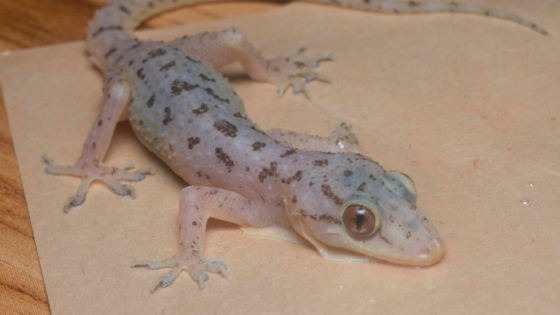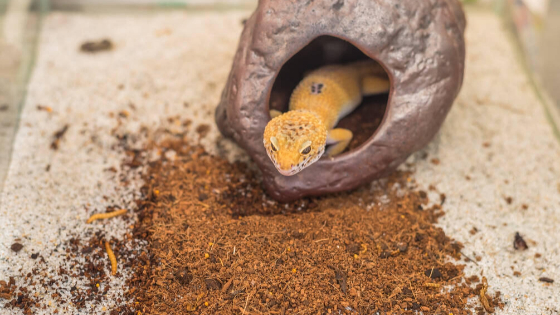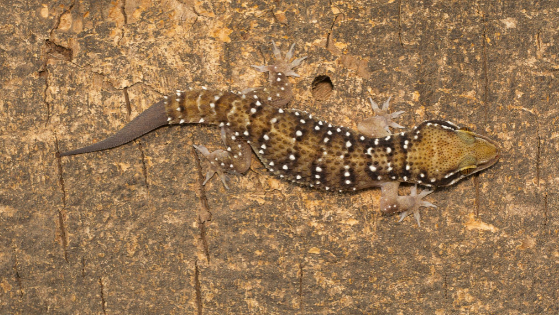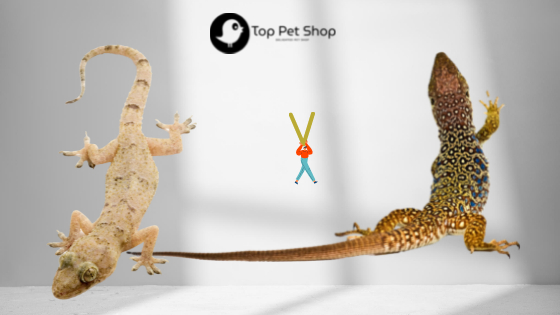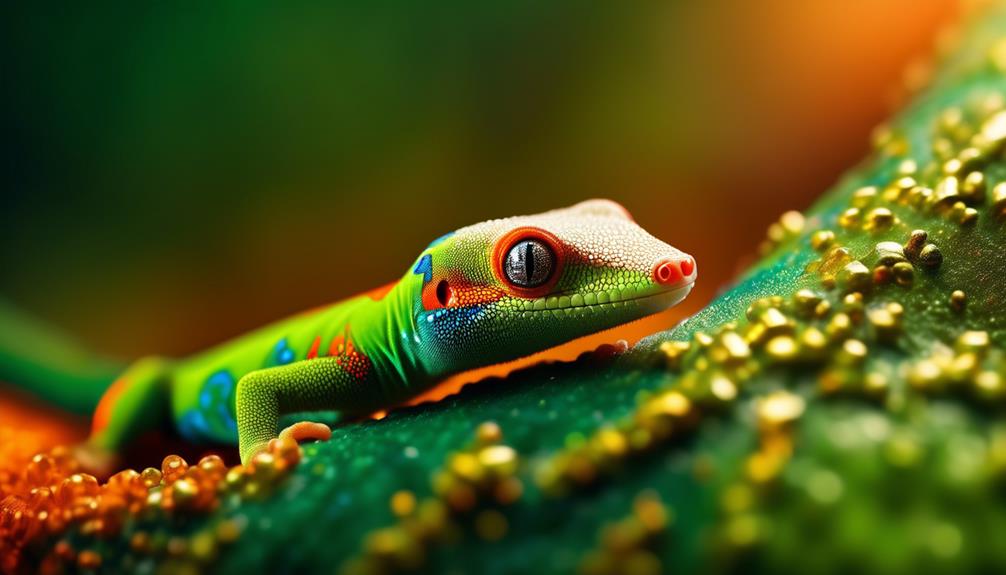
The Gold Dust Day Gecko, with its vibrant colors and captivating appearance, has become a prominent figure in the world of reptiles. From its striking green body adorned with red speckles to its territorial nature and unique dietary habits, this gecko has piqued the interest of researchers and pet enthusiasts alike.
But there is more to this remarkable creature than meets the eye. In this discussion, we will explore the various aspects of the Gold Dust Day Gecko’s life, from its physical characteristics and social behavior to its ecological role and scientific significance.
So, let us embark on a journey of discovery and uncover the fascinating world of this colorful gecko.
Key Takeaways
- The Gold Dust Day Gecko has a vibrant green or yellowish-green body color with red speckles and rust-colored transverse bars, providing camouflage among lush vegetation.
- Its unique adaptations, such as sticky toe pads for climbing and a flattened tail for balance, contribute to its survival and success in its natural habitat.
- The Gold Dust Day Gecko has a diverse diet, including insects, invertebrates, smaller lizards, and soft fruits. It is known to gather in groups to feed off a single plant.
- This species is native to Madagascar, Réunion, and Mauritius, but can also be found in some parts of the Hawaiian Islands. Habitat loss, introduced predators, and declining populations pose threats to its survival. Conservation programs and regulations are in place to protect the species.
Physical Appearance
The Gold Dust Day Gecko, a small reptile with a total length ranging from 3.9 to 5.1 inches (10-13cm), captures attention with its vibrant green or yellowish green body color. This striking coloration, combined with the red speckles on the neck and upper back, as well as the rust-colored transverse bars on the snout and head, make it a visually stunning creature.
Additionally, the gecko has a flattened tail and an off-white underside. Its physical appearance is not only aesthetically pleasing but also serves a purpose in its natural habitat. The bright colors help it blend into the lush foliage of its environment, providing camouflage from predators.
Dietary Habits
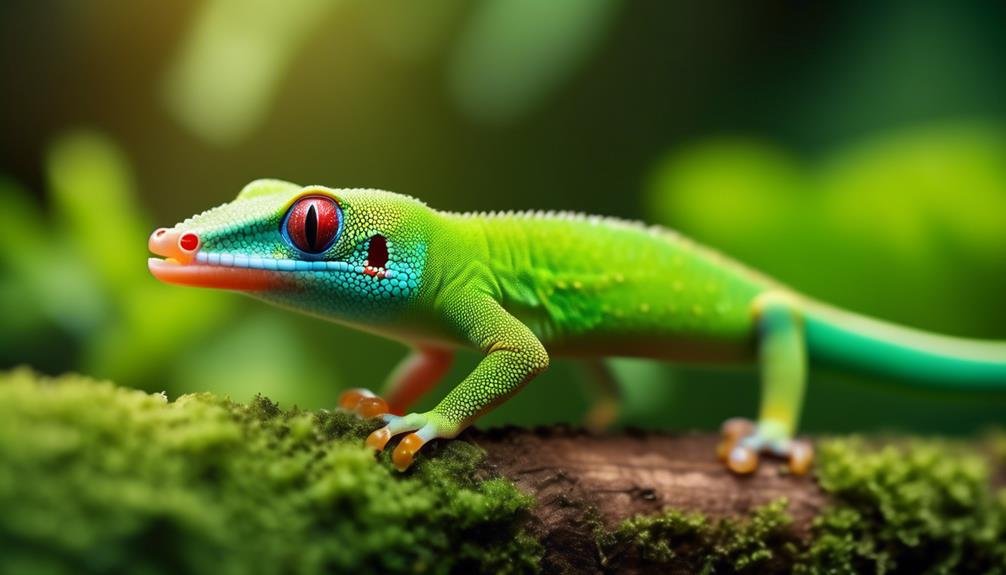
Continuing our exploration of the Gold Dust Day Gecko, we now turn our attention to its dietary habits. This vibrant reptile has a varied diet consisting of insects, invertebrates, and smaller lizards. It also consumes soft, sweet fruit and has been observed feeding on pollen and nectar from flowers. To make the information more visually engaging, here is a table summarizing the Gold Dust Day Gecko’s dietary habits:
| Food Type | Examples |
|---|---|
| Insects | Crickets, flies, spiders |
| Invertebrates | Beetles, worms, snails |
| Smaller lizards | Geckos, skinks, anoles |
| Soft, sweet fruit | Bananas, papayas, mangoes |
This gecko is known to gather in groups to feed off a single plant, and it has even been observed licking nectar from the bird of paradise flower. Its diverse diet contributes to its overall health and vitality, making it a fascinating species to study.
Social Behavior
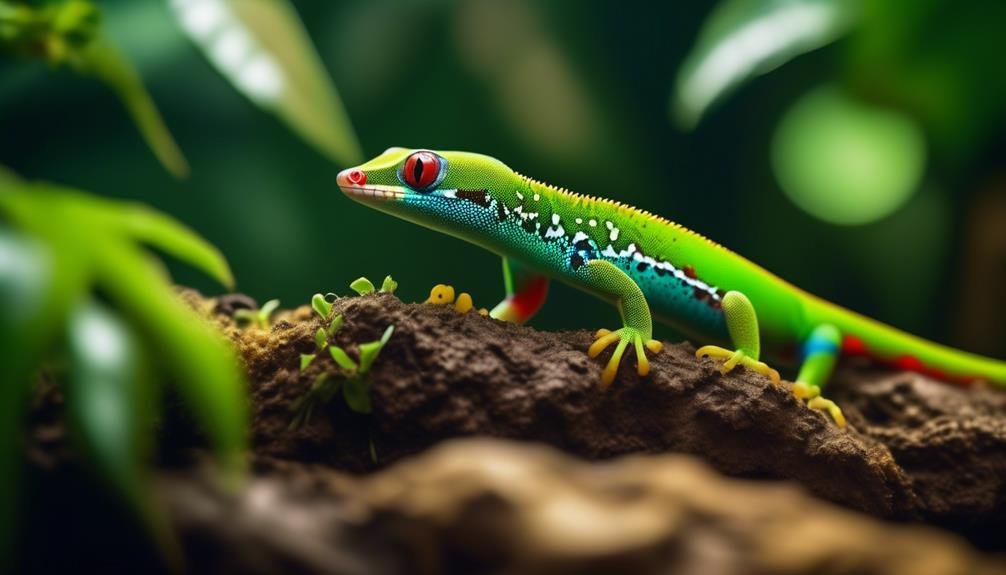
Gold Dust Day Geckos exhibit unique social behavior that is characterized by territorial aggression and intolerance towards other males in their territory. These geckos are known for their aggressive nature and their unwillingness to share their space with other males.
Their social behavior can be described as follows:
- Intense territorial disputes: Gold Dust Day Geckos engage in fierce battles with other males to establish dominance and protect their territory.
- Vocal communication: These geckos use vocalizations, such as chirping and hissing, to communicate with other individuals in their vicinity.
- Courtship rituals: During the mating season, males perform elaborate courtship displays to attract females and establish their reproductive dominance.
- Hierarchical structure: Within a territory, dominant males establish a hierarchical structure, with the most dominant male having access to the best resources and mates.
These social behaviors contribute to the survival and reproductive success of Gold Dust Day Geckos in their natural habitat.
Habitat and Distribution
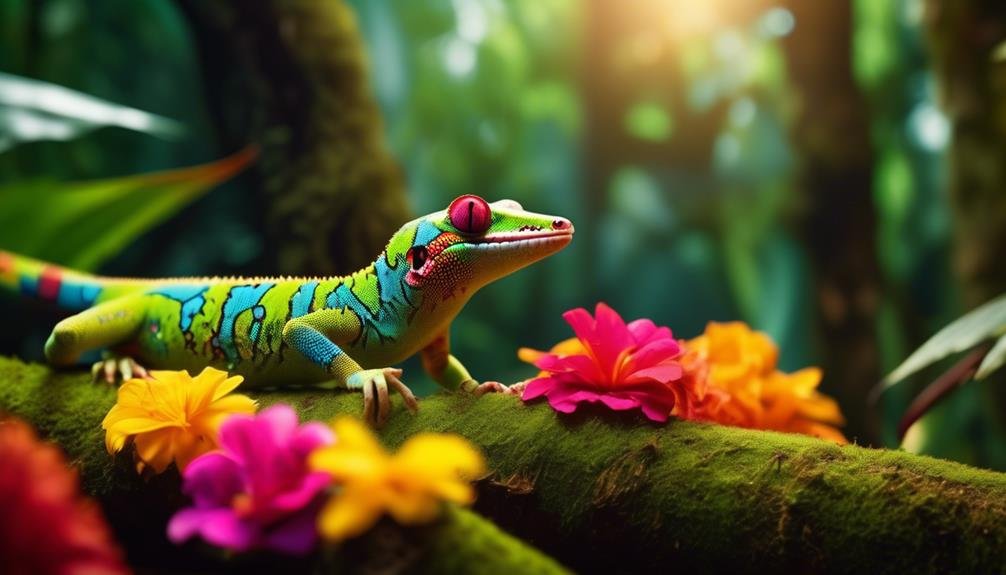
With its vibrant green and yellowish-green body, the Gold Dust Day Gecko stands out in its natural habitat. This species is native to the island of Madagascar, as well as the nearby islands of Réunion and Mauritius. It can also be found in some parts of the Hawaiian Islands, where it was introduced. Gold Dust Day Geckos inhabit a variety of environments, including rainforests, coastal areas, and urban gardens. They are arboreal, meaning they spend most of their time in trees and bushes. These geckos are well adapted to their surroundings, with specialized toe pads that allow them to climb and cling to various surfaces. Their distribution is largely determined by the availability of suitable vegetation and hiding places, as well as access to food sources.
| Habitat | Distribution |
|---|---|
| Rainforests | Madagascar |
| Coastal areas | Réunion |
| Urban gardens | Mauritius |
| Trees and bushes | Hawaiian Islands |
Reproduction and Life Cycle
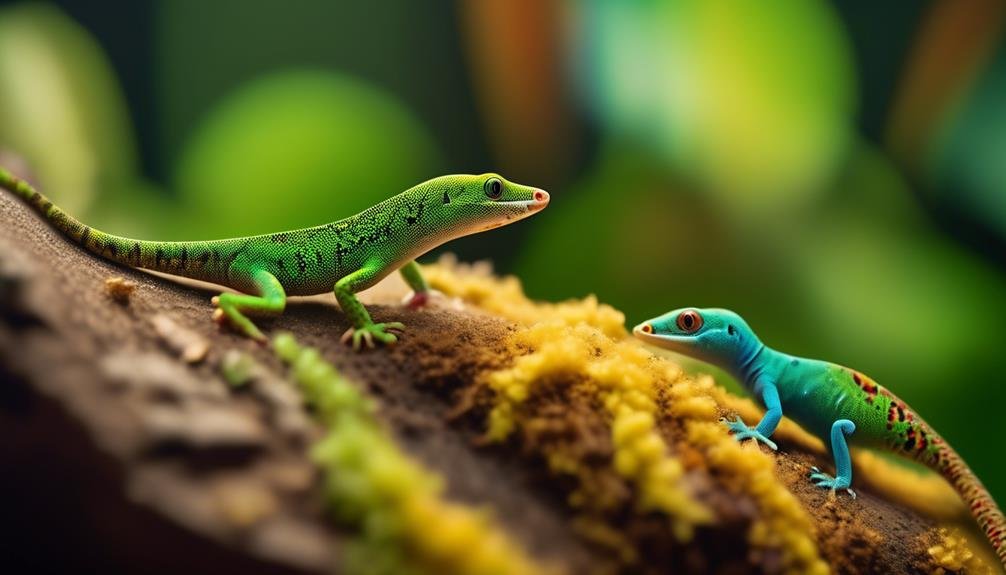
The reproductive process and life cycle of the Gold Dust Day Gecko are fascinating aspects of this species’ biology.
- Mating: Male geckos are known for their aggressive and territorial behavior. They court females by performing elaborate displays and head-bobbing movements.
- Egg-laying: After successful mating, females lay 1-2 eggs. These eggs are usually deposited in concealed locations, such as tree hollows or crevices.
- Incubation: The eggs have an incubation period of approximately 40-45 days. During this time, the female does not provide any parental care and the eggs are left to develop on their own.
- Juvenile stage: Once hatched, the juveniles measure around 55-60mm in length. However, due to their quarrelsome nature, it is recommended to keep them separately from other geckos.
The Gold Dust Day Gecko reaches sexual maturity after 10-12 months. This remarkable species showcases a complex and intriguing reproductive and life cycle.
Captive Care and Maintenance
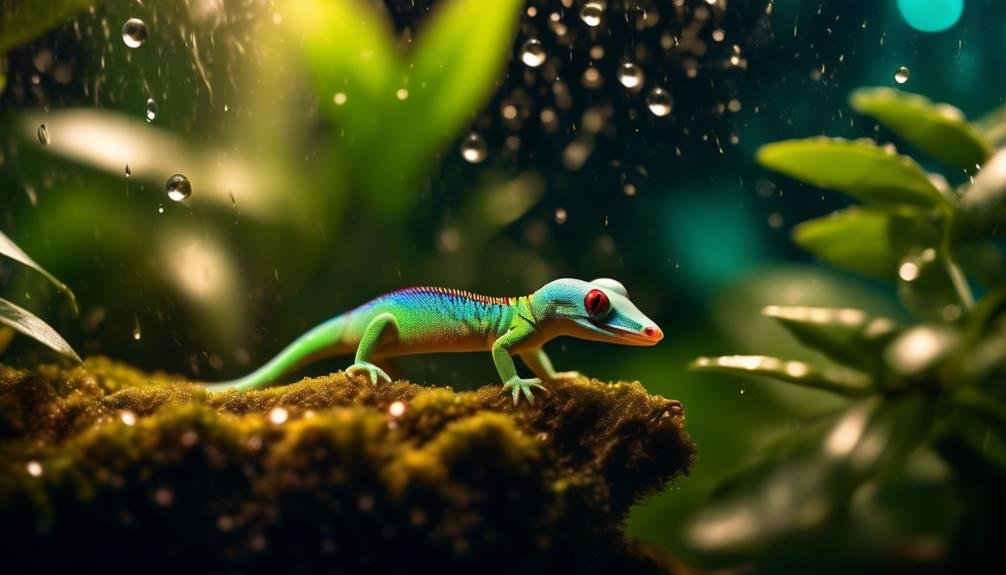
Following the fascinating reproductive process and life cycle of the Gold Dust Day Gecko, it is essential to delve into the necessary captive care and maintenance required to ensure the well-being of this captivating species.
Gold Dust Day Geckos are occasionally kept as pets and, with proper care, can live up to 15 years. To provide suitable care, they require a well-designed enclosure that mimics their natural habitat, including live plants, branches, and hiding spots.
Temperature and humidity levels should be maintained within the recommended range of 75-85 degrees Fahrenheit and 60-80%, respectively. A diet consisting of insects, invertebrates, and occasional fruit should be provided.
Regular veterinary check-ups are crucial to monitor the gecko’s health and address any potential issues. Captive breeding programs exist for this species, making it a popular choice among reptile enthusiasts.
Unique Adaptations
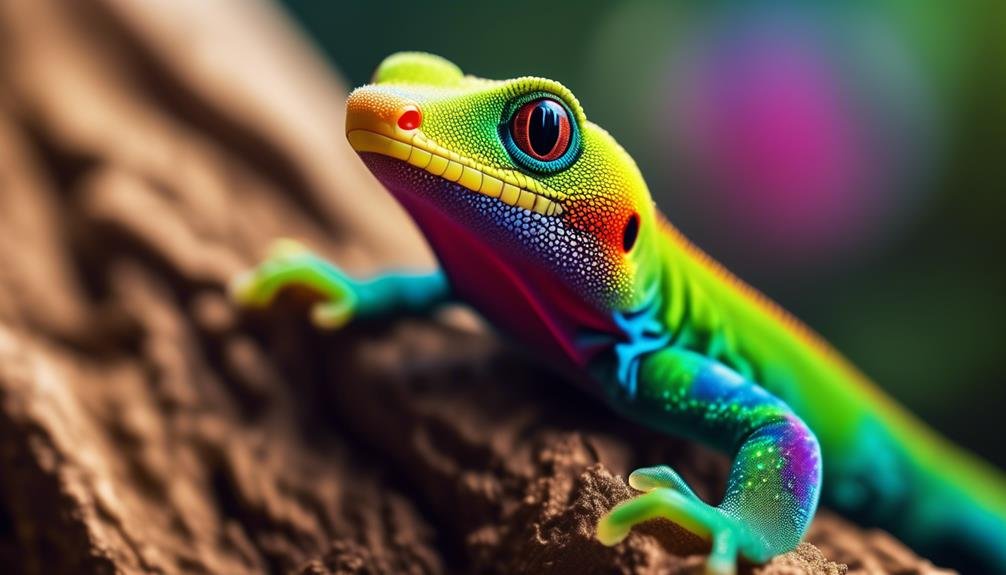
One remarkable aspect of the Gold Dust Day Gecko is its array of unique adaptations that contribute to its survival and success in its natural habitat.
These adaptations include:
- Sticky toe pads: The gecko has specialized toe pads covered in microscopic hairs that allow it to effortlessly cling to vertical surfaces, enabling it to navigate its arboreal environment with ease.
- Coloration: Its bright green or yellowish green body color, combined with red speckles on the neck and upper back, provides excellent camouflage among the lush vegetation, making it difficult for predators to spot.
- Flattened tail: The gecko’s flattened tail helps it maintain balance while climbing and jumping between branches, reducing the risk of falling.
- Nectar feeding: The Gold Dust Day Gecko has a unique ability to lick nectar from flowers, providing it with an additional food source and contributing to its overall fitness.
These adaptations highlight the remarkable evolutionary traits that have allowed the Gold Dust Day Gecko to thrive in its unique habitat.
Threats and Conservation Status
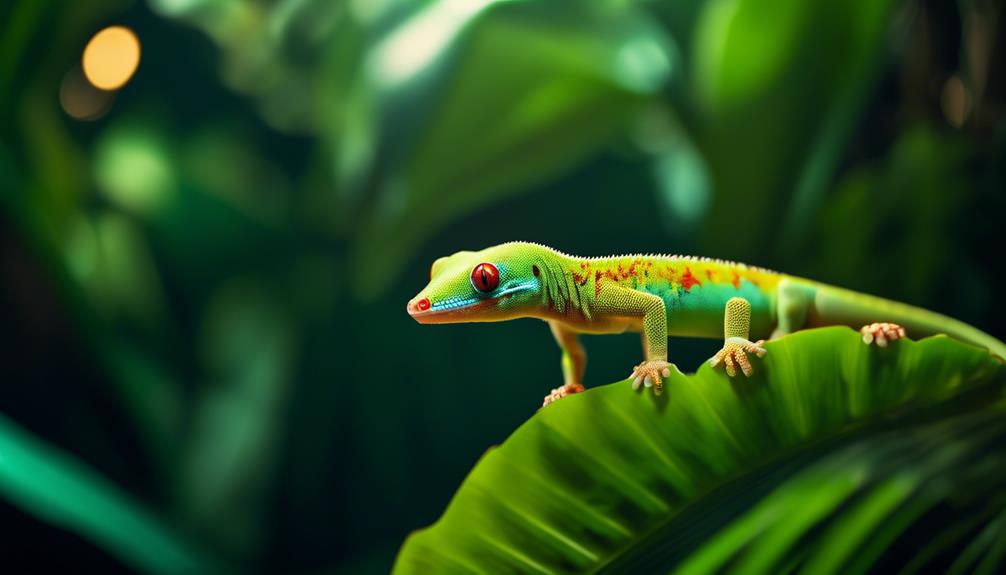
The Gold Dust Day Gecko faces various threats and is of concern for conservation efforts due to its vulnerability and declining populations.
One major threat to this species is habitat loss. The geckos rely on the vegetation in their native rainforest habitats, but these forests are being cleared for agriculture and urbanization.
Additionally, the introduction of non-native predators, such as rats and cats, has had a negative impact on the gecko population. These predators feed on the geckos and their eggs, further contributing to their decline.
Climate change is also a concern, as it can affect the gecko’s habitat and food availability.
Efforts are being made to protect the remaining populations and their habitats through conservation programs and regulations on habitat destruction.
It is important to continue monitoring and implementing conservation measures to ensure the survival of this colorful species.
Interesting Facts
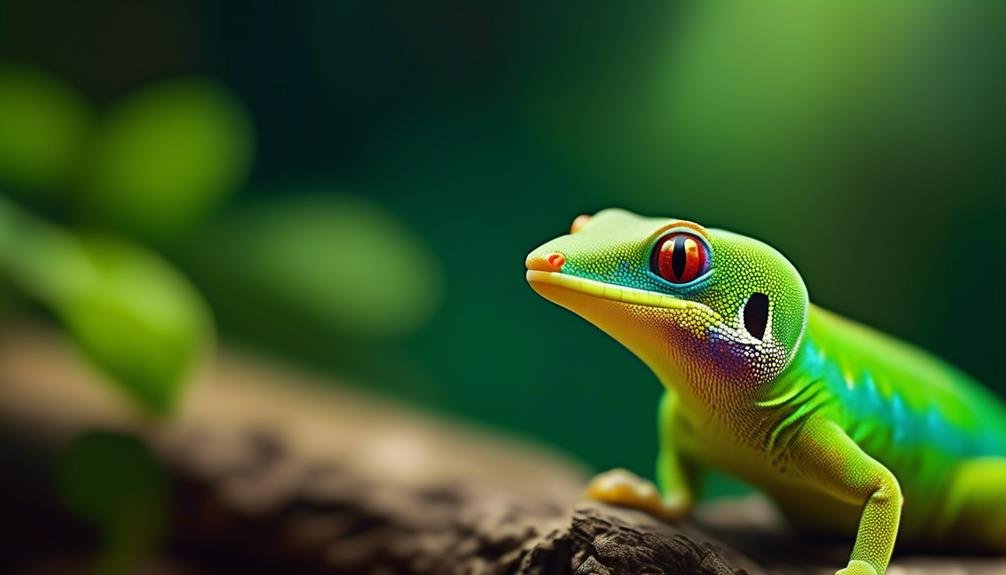
Gold Dust Day Geckos possess unique characteristics that make them fascinating creatures in the world of reptiles. Here are some interesting facts about these colorful geckos:
- They have the ability to change their color depending on their mood and environment, which adds to their charm and versatility.
- Gold Dust Day Geckos are excellent climbers and have specialized toe pads that enable them to stick to various surfaces, including glass.
- These geckos are known for their distinctive vocalizations, which include chirping sounds and squeaks, used for communication and territorial defense.
- Unlike many other reptiles, Gold Dust Day Geckos have the ability to blink their eyes, providing them with better protection and hydration.
These fascinating characteristics make Gold Dust Day Geckos a captivating species to observe and study.
Interaction With Humans
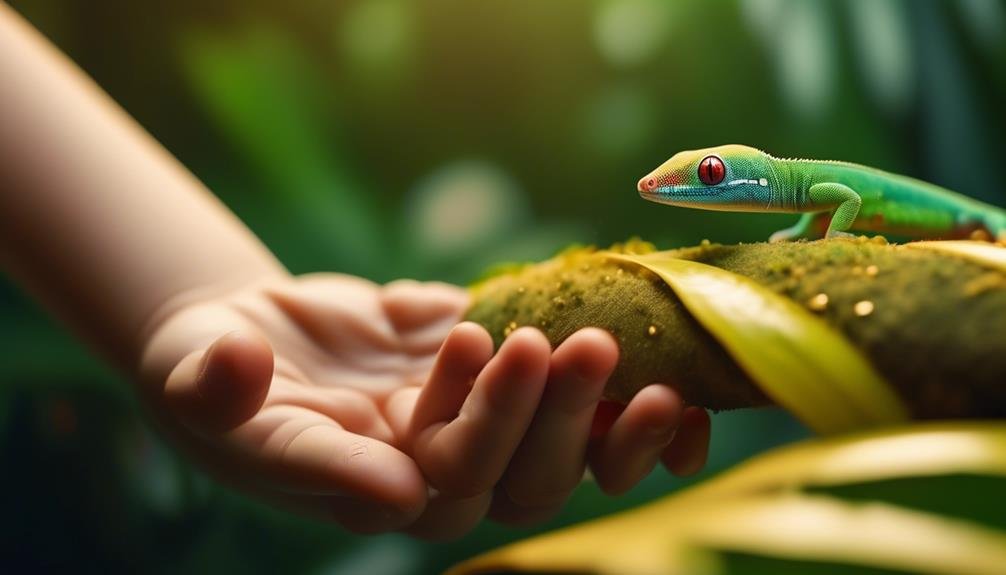
After exploring the unique characteristics of Gold Dust Day Geckos, it is intriguing to examine their interactions with humans. These geckos are occasionally kept as pets and have become a popular choice among reptile enthusiasts. When kept in captivity, they require a suitable enclosure and diet to thrive. With proper care, Gold Dust Day Geckos can live up to 15 years.
Additionally, captive breeding programs exist for this species, indicating a level of human interest and involvement in their conservation. However, it is important to note that these geckos can be quarrelsome, especially during their juvenile stage, and may need to be kept separately.
Natural Predators
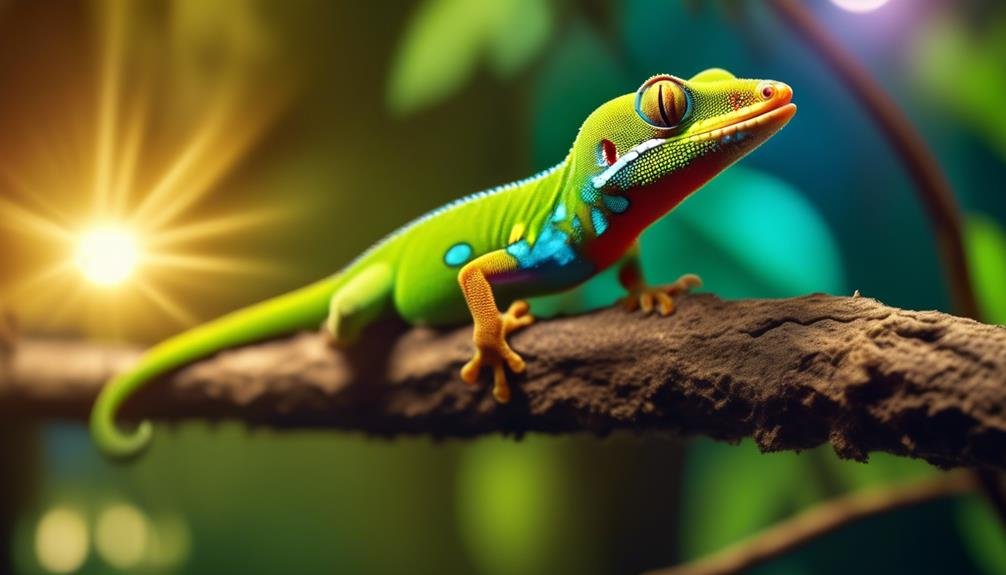
Natural predators pose a significant threat to the Gold Dust Day Gecko’s survival in its native habitat. These predators include:
- Birds of prey: With their keen eyesight and agility, birds such as hawks and owls can easily spot and capture these geckos, especially when they are out in the open.
- Snakes: Slithering silently through the vegetation, snakes like the Madagascar Green Tree Python see the gecko as a tasty meal.
- Mammals: Rats and other small mammals are known to prey on the Gold Dust Day Gecko, using their sharp teeth and agility to catch them.
- Invasive species: Introduced predators, such as the Indian Mongoose, have disrupted the delicate balance of the gecko’s ecosystem, posing a grave threat to their survival.
These natural predators constantly challenge the Gold Dust Day Gecko’s existence, making it imperative for conservation efforts to protect their native habitats and mitigate the impact of these threats.
Ecological Role
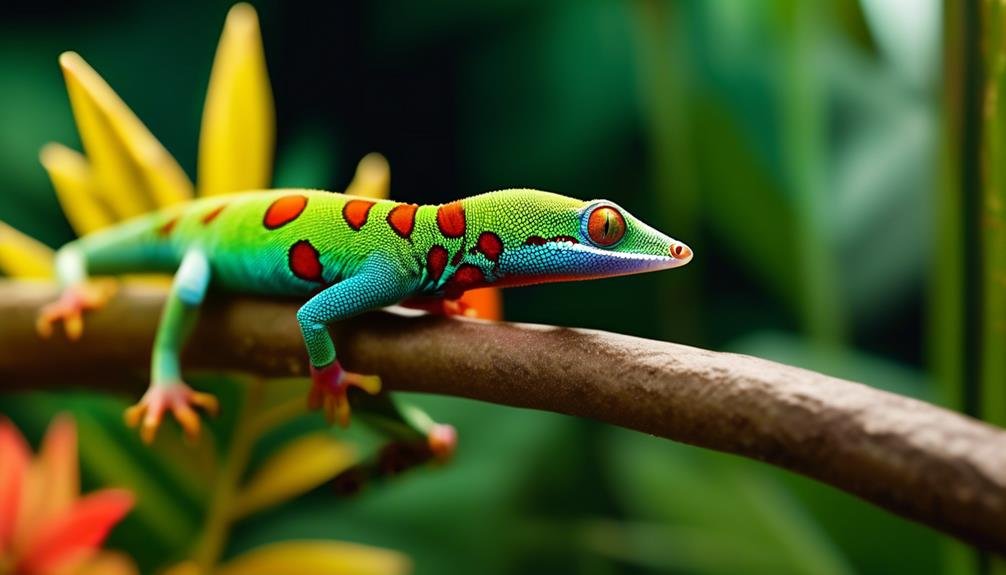
The Gold Dust Day Gecko’s survival in its native habitat is not only threatened by natural predators but also influenced by its important ecological role. As a voracious insectivore, this gecko plays a crucial role in regulating insect populations within its ecosystem. By feeding on insects, invertebrates, and smaller lizards, it helps to control their numbers and maintain a balance in the food chain.
Additionally, the Gold Dust Day Gecko contributes to pollination by consuming soft, sweet fruit, as well as pollen and nectar from flowers. This behavior aids in the dispersal of plant seeds and contributes to the overall health and diversity of the ecosystem.
Therefore, the presence of the Gold Dust Day Gecko is not only aesthetically pleasing but also essential for the ecological functioning of its habitat.
Color Variations
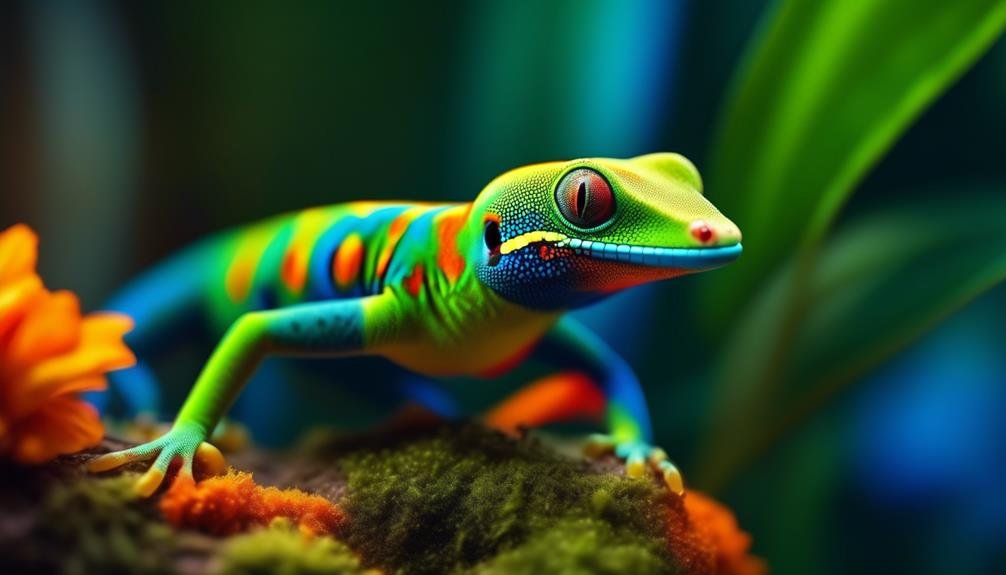
Exhibiting a range of vibrant hues, the Gold Dust Day Gecko showcases captivating color variations that contribute to its distinctive beauty. These variations include:
- Brilliant shades of green that mimic the lush foliage of its natural habitat, allowing it to blend seamlessly into its surroundings.
- Intricate red speckles on the neck and upper back, resembling scattered drops of crimson paint.
- Rust-colored transverse bars on the snout and head, lending a striking contrast to its predominantly green body.
- A flattened tail and off-white underside, providing a subtle yet elegant balance to its overall appearance.
These color variations not only serve as a visual delight but also play a crucial role in the gecko’s survival. They aid in camouflage, enabling the gecko to evade predators and capture prey more effectively.
Additionally, the vibrant colors serve as a means of communication within the species, allowing for intricate displays during courtship rituals. Such fascinating color adaptations truly make the Gold Dust Day Gecko a standout among its reptilian counterparts.
Vocalizations and Communication
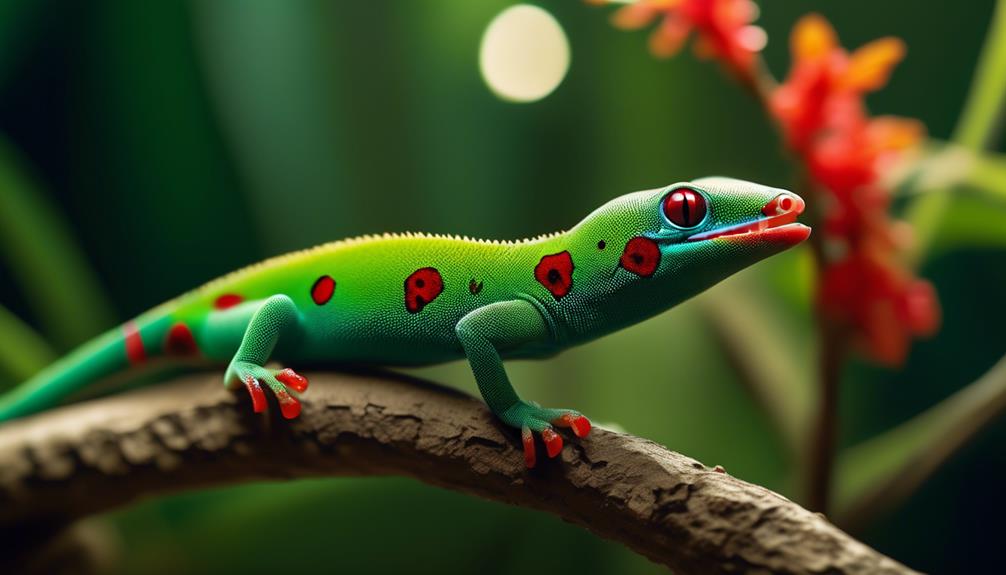
One prominent aspect of the Gold Dust Day Gecko’s behavior is its vocalizations and communication.
While these geckos are generally quiet creatures, they do have the ability to produce vocal sounds. They communicate through a series of chirps and squeaks, which are used for various purposes.
Males often use vocalizations to establish and defend their territories, signaling their presence to potential rivals. They may also make vocalizations during courtship rituals to attract females.
Additionally, these geckos may use vocalizations as a form of aggression or defense, especially when threatened or confronted by other males.
Research and Scientific Significance
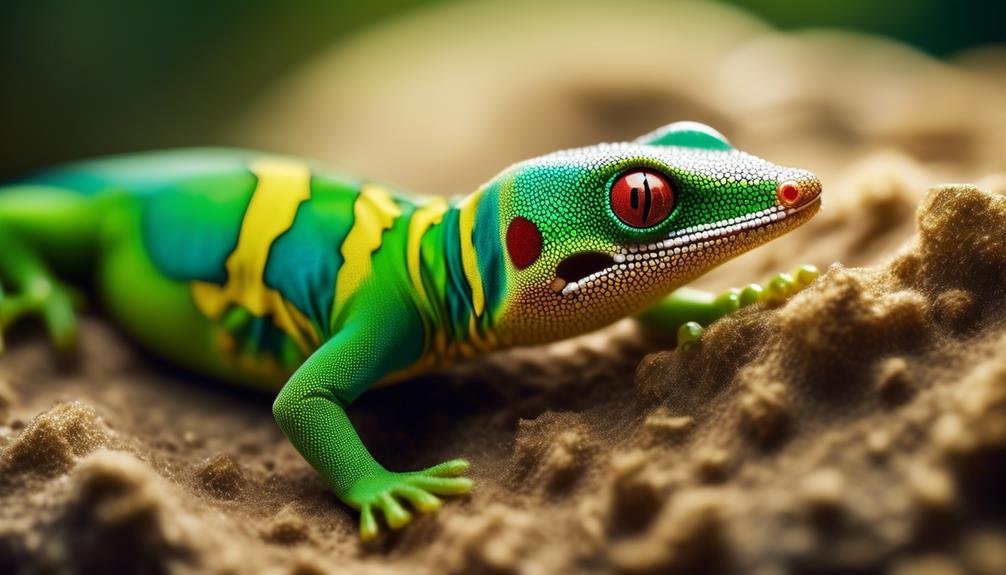
Research on the Gold Dust Day Gecko has significant scientific implications.
- Study of its coloration and patterns can provide insights into evolutionary adaptations for camouflage and predator avoidance.
- Investigation of its diet and feeding behavior can contribute to our understanding of food webs and ecological interactions in its native habitat.
- Research on its reproductive biology and breeding patterns can help us better understand the life history strategies of reptiles and contribute to conservation efforts.
- Analysis of its behavior and territoriality can provide valuable information on social dynamics and mate selection in reptiles.
Frequently Asked Questions
How Long Do Gold Dust Day Geckos Live in Captivity?
Gold dust day geckos can live up to 15 years in captivity with proper care. They require suitable enclosure and diet, and captive breeding programs exist for this species. They are a popular choice among reptile enthusiasts.
Are Gold Dust Day Geckos Commonly Kept as Pets?
Gold dust day geckos are occasionally kept as pets. With proper care, they can live up to 15 years. They require a suitable enclosure and diet in captivity. They are a popular choice among reptile enthusiasts.
What Is the Incubation Period for Gold Dust Day Gecko Eggs?
The incubation period for gold dust day gecko eggs is approximately 40-45 days. During this time, the eggs are kept in a suitable environment until they hatch into juveniles measuring around 55-60mm.
Do Gold Dust Day Geckos Have Any Unique Adaptations?
Gold dust day geckos have several unique adaptations. They possess a flattened tail and off-white underside, which aids in camouflage. They also have the ability to lick nectar from the bird of paradise flower, a specialized feeding behavior.
Are There Any Captive Breeding Programs for Gold Dust Day Geckos?
Yes, there are captive breeding programs for gold dust day geckos. These programs aim to ensure the sustainability of the species in captivity and reduce the demand for wild-caught individuals.
Are Leopard Geckos as Colorful as Gold Dust Day Geckos?
Leopard geckos are often admired for their stunning colors, but when it comes to comparing them with gold dust day geckos, the latter definitely steal the show. Known for their vibrant hues, gold dust day geckos are considered to be more colorful than leopard geckos, making them particularly sought after in the pet trade. Their dynamic and vivid appearance is a testament to the fascinating diversity found within the world of reptiles.
Conclusion
In conclusion, the Gold Dust Day Gecko, with its vibrant colors and unique behaviors, has become a popular choice among reptile enthusiasts and pet owners. Its visually appealing traits, such as its bright green body color and red speckles, make it a striking reptile to behold.
Additionally, its dietary habits, territorial nature, and reproductive characteristics contribute to its ecological role in its natural habitat.
Overall, the Gold Dust Day Gecko is a fascinating species that continues to captivate the attention of researchers and conservationists.

